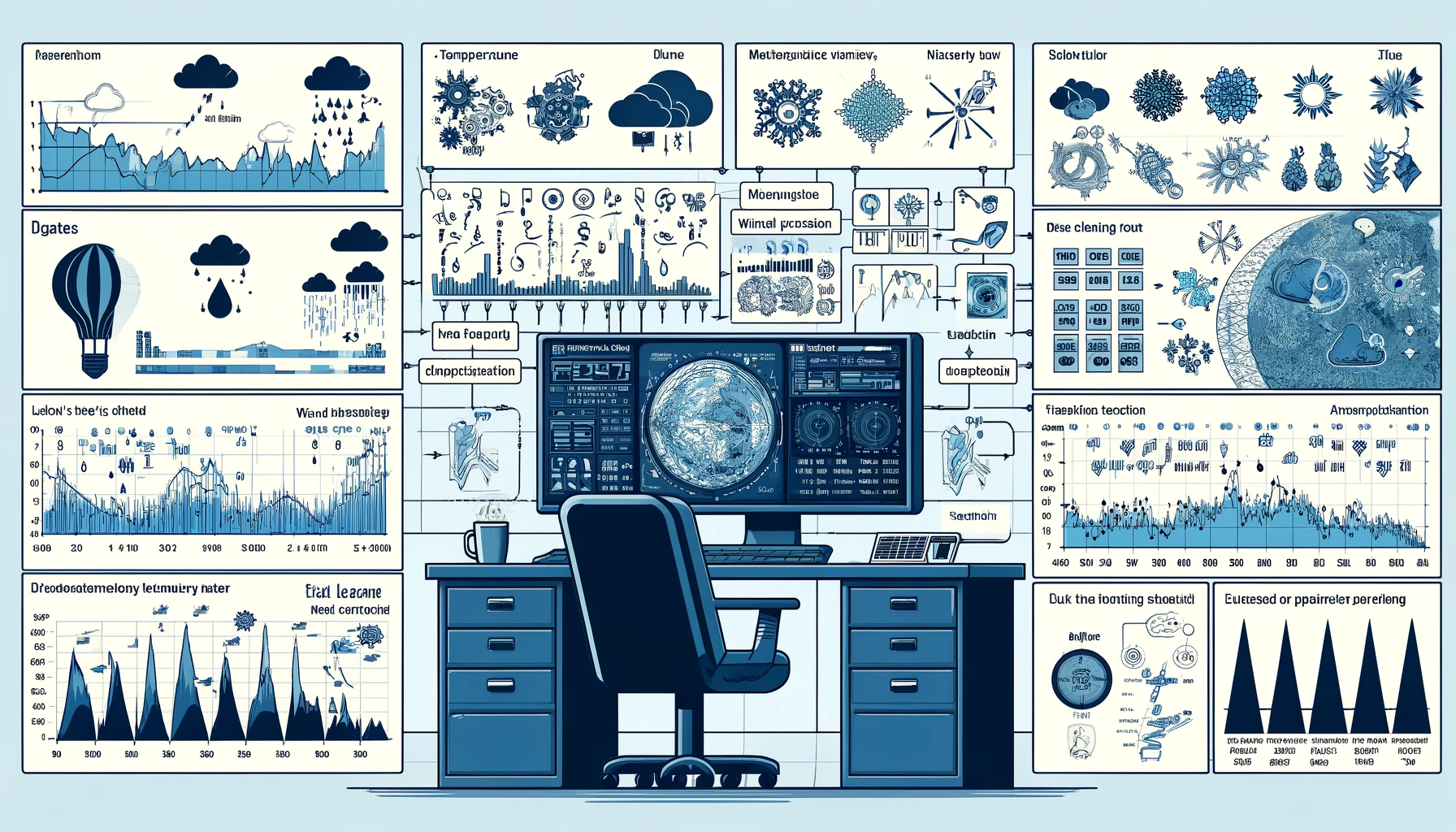Rainfall Prediction Using Machine Learning
Accurate rainfall prediction plays a crucial role in various sectors, including agriculture, water resource management, disaster preparedness, and urban planning. By accurately forecasting rainfall patterns, farmers can optimize irrigation schedules, minimize crop losses, and plan their activities accordingly. Additionally, reliable rainfall predictions help mitigate the impact of floods and droughts, enabling better emergency response and resource allocation. This effectiveness underscores the importance of Rainfall Prediction Using Machine Learning in enhancing the precision and utility of weather forecasts.
Brief Introduction to Machine Learning’s Role in Meteorology
Machine learning, a subset of artificial intelligence, has emerged as a powerful tool in meteorology, revolutionizing the way we analyze and predict weather patterns. By leveraging historical data, machine learning algorithms can identify intricate relationships and patterns, enabling more accurate rainfall predictions compared to traditional methods.
2. Understanding the Basics of Machine Learning
Definition of Machine Learning
Machine learning is a field of computer science that enables systems to learn and improve from experience without being explicitly programmed. It involves developing algorithms that can automatically identify patterns in data, make predictions, and adjust their behavior based on new information.
Key Machine Learning Concepts Relevant to Rainfall Prediction
- Supervised Learning: This technique involves training a model on labeled data, where the input and desired output are provided. The model learns to map the input features to the corresponding output, which in the case of rainfall prediction could be the amount or probability of precipitation.
- Unsupervised Learning: In this approach, the model is trained on unlabeled data, aiming to identify patterns and relationships within the data without explicit guidance. This technique can be useful for clustering weather patterns or detecting anomalies in rainfall data.
- Deep Learning: Deep learning is a subfield of machine learning that utilizes artificial neural networks with multiple layers to learn hierarchical representations of data. These models can effectively capture complex relationships in meteorological data, making them suitable for rainfall prediction tasks.
3. Why Use Machine Learning for Rainfall Prediction?
Advantages of Machine Learning over Traditional Methods
Traditional rainfall prediction methods, such as numerical weather models and statistical techniques, have limitations in capturing the intricate relationships and non-linear patterns present in meteorological data. Machine learning, on the other hand, offers several advantages:
- Ability to handle complex data: Machine learning algorithms can process large volumes of diverse data, including satellite imagery, radar data, and ground observations, enabling more comprehensive analyses.
- Adaptability: Machine learning models can continuously learn and adapt as new data becomes available, improving their accuracy over time.
- Non-linear modeling: Machine learning techniques can effectively model non-linear relationships, which are common in meteorological phenomena.
- Parallelization and scalability: Many machine learning algorithms can be parallelized and scaled to handle large datasets efficiently, enabling faster and more accurate predictions.
Examples of Successful Applications
Machine learning has been successfully applied in various rainfall prediction scenarios, including:
- Short-term precipitation forecasting: Machine learning models have demonstrated their ability to accurately predict rainfall events in the next few hours or days, assisting in real-time decision-making and emergency preparedness.
- Seasonal rainfall prediction: By analyzing historical data and incorporating factors such as sea surface temperatures and atmospheric patterns, machine learning models can provide valuable insights into seasonal rainfall trends, aiding agricultural planning and water resource management.
- Extreme rainfall event prediction: Machine learning techniques have shown promise in identifying and forecasting extreme rainfall events, which are crucial for mitigating the impact of floods and landslides.
4. Data Collection for Rainfall Prediction
Sources of Meteorological Data
Accurate rainfall prediction relies on a diverse set of meteorological data sources, including:
- Ground-based observations: Data from weather stations, rain gauges, and other ground-based instruments provide direct measurements of rainfall, temperature, humidity, wind speed, and other relevant variables.
- Remote sensing data: Satellite imagery, radar data, and other remote sensing technologies offer valuable information about cloud cover, atmospheric moisture content, and precipitation patterns over large geographical areas.
- Reanalysis datasets: These datasets combine historical observations with numerical weather models to provide a comprehensive representation of past weather conditions, serving as a valuable source of training data for machine learning models.
Important Variables and Data Preprocessing
To effectively train machine learning models for rainfall prediction, various meteorological variables need to be considered, including:
- Temperature
- Humidity
- Wind speed and direction
- Atmospheric pressure
- Cloud cover
- Precipitation type (e.g., rain, snow, hail)
Data preprocessing is crucial to ensure the quality and consistency of the input data. This may involve handling missing values, removing outliers, and normalizing or scaling the data to ensure compatibility with the chosen machine learning algorithm.
5. Exploratory Data Analysis in Rainfall Prediction
Analyzing Historical Weather Data
Before building a machine learning model, it is essential to conduct exploratory data analysis (EDA) on the available historical weather data. EDA involves:
- Visualizing the data to identify patterns, trends, and potential outliers
- Analyzing the distribution of variables and their relationships
- Identifying potential correlations between variables and rainfall patterns
- Detecting seasonality or cyclic patterns in the data
Identifying Patterns and Anomalies
Through EDA, researchers can uncover valuable insights, such as:
- Seasonal variations in rainfall patterns
- Relationships between atmospheric conditions and precipitation events
- Anomalies or extreme weather events that may require special handling
- Geographic or topographic influences on rainfall distribution
These insights can guide feature selection, data preprocessing, and the choice of appropriate machine learning models for rainfall prediction.
6. Selecting the Right Machine Learning Model
Comparison of Various Machine Learning Models
Several machine learning models have been employed for rainfall prediction, each with its own strengths and weaknesses. Some commonly used models include:
- Linear Regression: A simple model suitable for capturing linear relationships between input features and rainfall amounts.
- Decision Trees and Random Forests: Tree-based models that can handle non-linear relationships and are effective for both classification (rain/no rain) and regression (rainfall amount) tasks.
- Support Vector Machines (SVMs): Powerful algorithms that can model complex non-linear relationships and are well-suited for high-dimensional data.
- Neural Networks: Highly flexible models that can capture intricate patterns in data, making them suitable for complex rainfall prediction tasks.
- Ensemble Methods: Techniques that combine multiple models, such as random forests or gradient boosting, to improve overall prediction accuracy.
Criteria for Selecting the Appropriate Model for Rainfall Prediction
When selecting a machine learning model for rainfall prediction, several factors should be considered:
- Accuracy: The model should demonstrate high predictive accuracy on unseen data.
- Interpretability: Depending on the application, the model’s ability to provide interpretable results may be desirable, especially for decision-making processes.
- Computational efficiency: For real-time or time-sensitive applications, the model should be computationally efficient and able to make predictions quickly.
- Handling of non-linear relationships: Rainfall patterns often exhibit non-linear relationships with various meteorological variables, requiring models that can capture these complexities.
- Robustness to noise and outliers: Meteorological data can be prone to noise and outliers, necessitating models that are resilient to such issues.
The choice of model ultimately depends on the specific requirements of the rainfall prediction task, the available data, and the desired trade-off between accuracy, interpretability, and computational complexity.
7. Feature Engineering for Rainfall Prediction
Important Features for Predicting Rainfall
Effective machine learning models for rainfall prediction rely on a combination of relevant features derived from meteorological data. Some important features include:
- Temperature and humidity: These variables play a crucial role in atmospheric moisture content and precipitation formation.
- Wind speed and direction: Wind patterns can influence the movement and distribution of precipitation systems.
- Atmospheric pressure: Changes in atmospheric pressure can indicate the formation or dissipation of weather systems.
- Satellite and radar data: These data sources provide valuable information about cloud cover, precipitation patterns, and atmospheric moisture content.
- Geographic and topographic features: Factors such as elevation, proximity to water bodies, and terrain features can influence local rainfall patterns.
Techniques for Feature Extraction and Selection
To improve model performance and reduce computational complexity, feature engineering techniques are often employed:
- Feature extraction: Deriving new features from existing data, such as calculating atmospheric instability indices or combining multiple variables into a single feature.
- Feature selection: Identifying the most relevant features and removing redundant or irrelevant ones, which can improve model interpretability and reduce overfitting.
Common techniques for feature selection include correlation analysis, recursive feature elimination, and regularization methods like LASSO or Ridge regression.
Building a Machine Learning Model for Rainfall Prediction
Step-by-Step Model Development
- Data Collection: Gather historical rainfall data, atmospheric conditions, and geographical information.
- Data Preprocessing: Cleanse the data by handling missing values and anomalies.
- Model Selection: Choose appropriate machine learning models like linear regression, decision trees, or neural networks based on the problem complexity.
- Model Training: Train the model using historical data to learn rainfall patterns.
- Model Evaluation: Assess the model’s performance using metrics like Mean Squared Error (MSE) and Accuracy.
Training the Model with Historical Data
- Data Splitting: Divide the data into training and testing sets.
- Cross-Validation: Use techniques like k-fold cross-validation to ensure the model’s effectiveness across different data subsets.
- Parameter Tuning: Adjust model parameters to find the optimal settings for the best performance.
Enhancing Machine Learning Models for Better Rainfall Prediction
Techniques to Boost Model Accuracy
- Feature Engineering: Enhance model input using relevant features such as humidity and temperature changes.
- Algorithm Tuning: Fine-tune the algorithms to adapt better to the specifics of rainfall data.
Learning from Success
- Case Studies: Discuss successful implementations and the techniques that led to improved accuracy, such as the integration of radar and satellite data.
Implementing Machine Learning Models in Production
From Model to Real-Time Prediction
- Deployment: Deploy the trained models to operational systems to provide real-time rainfall predictions.
- Integration: Seamlessly integrate the models with existing weather forecasting systems to enhance predictive capabilities.
Addressing Challenges in Rainfall Prediction
Common Pitfalls and Strategic Solutions
- Overfitting and Underfitting: Implement strategies like regularization and model simplification to balance the model’s complexity and training data variance.
- Data Quality Issues: Employ advanced data cleansing techniques to improve the quality and reliability of the input data.
Future Directions in Rainfall Prediction with Machine Learning
Innovations on the Horizon
- Emerging Technologies: Explore the potential of deep learning and artificial neural networks in capturing more nuanced rainfall patterns.
- Methodology Enhancements: Predict advancements in algorithms that could lead to more accurate and timely predictions.
In-Depth Case Study: Successful Implementation
Detailed Examination of a Success Story
Background
This case study focuses on a project undertaken by a collaborative team from a national weather service and a leading technology university. The primary objective was to enhance the accuracy of short-term rainfall predictions in a region prone to sudden and severe weather changes. The team aimed to integrate machine learning models with existing meteorological systems to predict rainfall more accurately up to 48 hours in advance.
Implementation Details
- Data Collection and Preparation:
- Data Types: The project utilized a combination of historical weather station data, satellite imagery, and radar data.
- Preprocessing: Data was cleaned and normalized to handle discrepancies and missing values, ensuring the models had high-quality input data.
- Machine Learning Techniques Used:
- Neural Networks: Deep learning models, specifically Convolutional Neural Networks (CNNs), were trained to recognize patterns in spatial data from radar and satellite images.
- Ensemble Methods: To improve reliability, the team employed ensemble methods combining predictions from multiple models, including Gradient Boosting Machines (GBM) and Random Forests.
- Integration with Meteorological Systems:
- The machine learning models were integrated into the existing weather forecasting framework using API connections, allowing real-time data flow and model updating.
- A user interface was developed for meteorologists to interact with the predictive models, providing them with real-time predictions and confidence intervals.
Outcomes
- Improvement in Prediction Accuracy:
- The implementation of machine learning models led to a significant improvement in the accuracy of rainfall predictions. The predictive accuracy for 24-hour forecasts increased by approximately 15%, and for 48-hour forecasts by about 10%.
- The models were particularly effective in predicting the onset and intensity of rainfall, which was a challenge with traditional forecasting methods.
- Impact on Decision-Making Processes:
- The improved predictions enabled better preparedness for weather-related emergencies. Local governments and disaster management teams were able to deploy resources more effectively, reducing the impact of floods and other weather-related hazards.
- Farmers and agricultural businesses used the more accurate forecasts to optimize irrigation and protect crops, significantly reducing water use and crop loss.
- Feedback and Future Plans:
- Feedback from users, including meteorologists and emergency planners, has been overwhelmingly positive, highlighting the enhanced ability to make informed decisions.
- The project team plans to further refine the models by incorporating more granular data and exploring additional machine learning techniques to handle unexpected weather patterns.
This case study exemplifies how machine learning can transform rainfall prediction, providing substantial benefits across various sectors by enhancing the accuracy and timeliness of forecasts. The success of this project serves as a model for other regions with similar climatic challenges, showcasing the potential for machine learning to revolutionize meteorological predictions.
Essential Resources and Tools for Rainfall Prediction Using Machine Learning
Must-Have Tools for Practitioners
Software Recommendations:
- Python and R: These programming languages are essential due to their extensive libraries and frameworks that facilitate statistical analysis and machine learning. Python, with libraries like Pandas, NumPy, Scikit-learn, TensorFlow, and PyTorch, is particularly favored for its versatility and ease of use. R is also widely used, especially for statistical analysis and plotting.
- MATLAB: Renowned for its powerful toolboxes and ability to handle matrix operations and complex calculations, MATLAB is often used in academia and research for developing advanced weather models.
- Google Earth Engine: This tool is invaluable for accessing and analyzing vast amounts of geospatial data, including historical weather patterns and satellite images, making it perfect for integrating environmental data into predictive models.
- IBM Weather Company Data Packages: These provide extensive weather data APIs that can be integrated into machine learning models to access real-time and historical weather data.
- Jupyter Notebooks: Ideal for prototyping and visualization, Jupyter Notebooks support Python code and allow data scientists to create and share documents that contain live code, equations, visualizations, and narrative text.
Comparison of Tools:
| Software | Strengths | Ideal Usage |
|---|---|---|
| Python/R | Extensive libraries, strong community support | General machine learning and data analysis |
| MATLAB | Advanced numerical capabilities, robust toolboxes | Complex model development, academic research |
| Google Earth Engine | Access to extensive geospatial data, powerful analytics | Environmental data integration |
| IBM Weather Company Data | Real-time data access, global coverage | Real-time prediction models |
| Jupyter Notebooks | Interactive, supports visualization | Data exploration, sharing results |
Learning Resources
Books:
- “Machine Learning for Absolute Beginners” by Oliver Theobald: Offers a clear introduction to the basics of machine learning, ideal for newcomers.
- “Pattern Recognition and Machine Learning” by Christopher M. Bishop: A more advanced text that delves into the algorithms and theory of machine learning.
- “Data Mining and Predictive Analysis” by Colleen McCue: Focuses on predictive modeling, including weather prediction using data mining techniques.
Frequently Asked Questions
Q:What are the best machine learning models for rainfall prediction?
A: The most effective models often include neural networks, decision trees, and ensemble models like random forests and gradient boosting machines. The choice depends on the specific characteristics of the data and the prediction needs.
Q: How does machine learning improve the accuracy of rainfall predictions?
A: Machine learning improves accuracy by processing and learning from large volumes of diverse data, enabling the models to uncover non-linear relationships and subtle patterns not easily captured by traditional forecasting methods.
Q: What are the challenges of using machine learning in real-time weather forecasting?
A: Challenges include managing vast amounts of real-time data, ensuring the computational efficiency of models for quick predictions, and maintaining the models’ accuracy over time as weather patterns evolve. Additionally, integrating these models into existing meteorological infrastructure requires careful planning and resources.
Q: How can we ensure the reliability of machine learning models in rainfall prediction?
A: Reliability can be ensured through rigorous model validation, continuous training with updated data, and using ensemble techniques to average out predictions from multiple models to reduce errors and increase confidence in the predictions.
Q: Can machine learning models for rainfall prediction adapt to climate change?
A: Yes, machine learning models are inherently adaptable and can continuously learn from new data, including emerging patterns resulting from climate change. This adaptability is crucial for maintaining the accuracy of predictions in a changing climate.
Conclusion
In summary, machine learning offers transformative potential for improving rainfall prediction, essential for agriculture, urban planning, and disaster management. This technology enables more accurate forecasts by learning from vast datasets, identifying complex patterns that traditional methods might overlook. As we move forward, advancements in AI and computing power are expected to further enhance these capabilities. The continuous evolution of machine learning techniques promises not only to improve the accuracy of weather predictions but also to revolutionize the way we prepare for and respond to meteorological events.

















